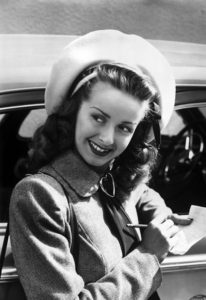
Noel Neill, who played Lois Lane in the original Superman serial, passed away this past Sunday, July 3. It seems appropriate, then, to pull out an old review I did for the Superman serial way back in 2004. Never published, so you’re reading it for the first time right here. And you are now in the year 2004…
I just finished watching the first of the two Superman serials, the 1948 one simply titled Superman. Pretty good for a Columbia serial. I’ve always had a fond spot in my heart for Columbia serials, but I know that in the serial community they aren’t as highly regarded as the Republic efforts.
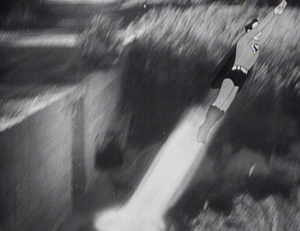
As many people have pointed out, the animated special effects are jarring. When Superman takes to the air, his real-life figure is replaced by a cartoon. It allows him to do many things that would be difficult to otherwise do, but I personally found it a big distraction. Animation was used for other special effects scenes, as well the flying scenes. The tornado in chapter one is animated, as is the spaceship that carries the infant Superman to Earth. And the exploding planet, itself. Animated bullets bounce off Superman’s chest in several chapters. An animated meteor crashes to earth in chapter three. And in chapter eight, some rocket-laden kryptonite is launched at Superman; it’s animated.
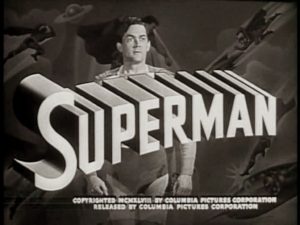
I hate to play the “if only” game, but as so many other people have pointed out, if only Columbia had hired Theodore and Howard Lydecker from Republic to do their special effects, this serial could have been so much better. Using the flying techniques they perfected seven years earlier with Captain Marvel would have been much more believable. But alas, it was not to be, and we must be satisfied with what we have. And it’s still a wonderful serial in its own right.
Chapter one introduces the origin of Superman. We see his home planet of Krypton, his parents and his escape via rocketship just before the planet explodes. We see the crash landing on Earth, the infant being found by the Kents, and Superman growing up and discovering his powers. All in the first episode! But wait, there’s more!
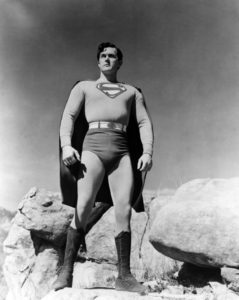
After Clark Kent is grown, his parents sit him down to have “the talk.” He came to them from out of the sky, he has all these powers, they must be used for good, etc. Oh yes, and here’s a uniform made by his foster mom. She explains it’s made from the blankets they found him wrapped in. It’s impervious to fire and acid. But apparently not scissors. Sorry… just sayin’.
Shortly after the Kents have their talk with young Clark, they pass away, and Clark heads out to the big city of Metropolis. On the way, he witnesses an impending disaster: a train wreck in the making. And thus ends chapter one. That’s a lot to cram into 20 minutes!
Chapter two gets Clark Kent established in Metropolis as a newspaper reporter at the Daily Planet. But it’s in chapter three where the serial really starts. It’s in chapter three where we meet the Spider Lady. And we meet good old Dr. Graham who has invented a “relativity reducer ray” machine. This doesn’t seem to actually do any “reducing,” however. It just reduces things to rubble. It can destroy a target thousands of miles away with more power than an atomic bomb! Definitely a device worthy of being stolen by the Spider Lady!
Chapter three also introduces us to Kryptonite! (Kryptonite, by the way, was originally introduced in the Superman radio show, five years earlier.) Apparently an asteroid has been circling the sun and is entering Earth’s gravity. Originally from the planet Krypton, the meteor lands conveniently close to Metropolis and is brought to the Metropolis Museum by Professor Arnold Leeds. When he shows the strange meteorite to reporter Clark Kent, Kent reels and passes out. Oooh, nasty stuff! So now, with chapter three out of the way, the serial has really started!
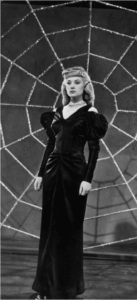
For the rest of the 15 chapters, the Spider Lady is out to get the relativity reducing ray machine. But she’s constantly thwarted by Lois Lane, Jimmy Olsen and Clark Kent. Superman is called upon by the Secretary of National Security (now, there’s an interesting title) to help guard the machine. As we all know, in the end the Spider Lady will lose, and Superman will have survived various cliffhangers to finally triumph in his never-ending battle for truth, justice, and the American way.
Just about all the other serials I’ve seen rely on fist fights and gun battles to help fill out each chapter. This serial is the exception. You can’t have a fist fight with Superman. You’d break your fist. Or gun battles, either. The bullets bounce off, you know. So the writers had to find other ways to pad out the 15 to 18 minutes allotted to each chapter. Because of this, the serial had a little more plot than most. I guess it actually needed more of a story, since the missing fist fights and gun battles left lots of extra time.
That’s not to say there weren’t any fist fights in the serial. In fact, it seems like in just about every chapter, Jimmy Olsen got in a fist fight with some underling of the Spider Lady. But it was always a quick scuffle of two or three punches in which poor Jimmy was inevitably knocked out. Actually, that seemed to be his specialty in the serial: getting knocked out.
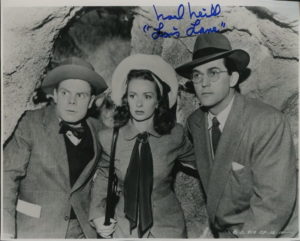
The longest fist fight in the entire serial was in chapter 13 when Perry White gets into a fight with Anton, a minion of the Spider Lady that Superman has caught. Perry lost, by the way. And Jimmy Olsen continued to get knocked out in every fight right up until the final chapter. Then, happily, in chapter 15, Jimmy Olsen finally strikes a telling blow and knocks out the Spider Lady’s chief lieutenant. Whew! It was about time!
And there were a few gun battles, as well. But again they were short. Not the long protracted gunfights from the other serials, where a six-shooter holds at least 20 bullets and nobody ever seems to hit anybody else. These were shorter gunfights. A thug would whip out a revolver and take three shots at Superman. The animated bullets would bounce off Superman’s chest and that would be the end of the gun battle.

I was very intrigued by the “relativity reducing ray” introduced in chapter three. Although it was the main focus of the running plot, we only got to see it in action twice. All through the serial, this was what the good guys were protecting and the bad guys were trying to steal. If it was so vital, it seems like we should have gotten a better sample of what powerful things it could do. But alas, all we got to see it do was blow up a small cement blockhouse in chapter three, and destroy a jail cell in chapter 15. Nowhere was this supreme weapon “more powerful than an atomic bomb” demonstrated as fully as it was being claimed. Where are those stock footage clips of atomic explosions when you need them?
A few final notes. Never once do I remember hearing Perry White exclaim “Great Caesar’s Ghost” like he did on the TV show. Clark, Jimmy, and Lois would refer to him as “chief,” but never did he respond with “Don’t call me chief!” Maybe that was only from the TV series, as well.
One small goof was noticed in chapter 14. The boom microphone was clearly visible in the reflection of a car’s shiny finish. That’ll teach them to wash those cars! They should have thrown some dust on the car, to cut down on the reflection. But as usual with serials, I’m sure they were in a hurry and didn’t have a lot of money for reshoots.
The music played behind the main title was super! Forgive the pun. It wasn’t the radio theme or that from the movie cartoons. But it was really a rousing and exciting piece. Unfortunately, it was only used in the opening credits. Nothing of that music was heard as background in the actual chapters themselves.
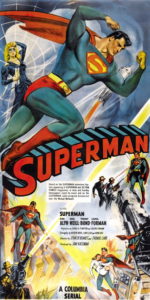
And speaking of credits, all the actors were listed in the credits except for Superman himself. No credit for Kirk Alyn. That seems strange. I wonder why? Were they originally there, but were cut on the laserdisc version I watched? If anyone can shed any light on that, I’d sure like to know.
The serial is one that I can recommend. If you can look past the animated special effects, which would likely otherwise ruin the continuity for you. Two years after this review was originally written, an official studio-released DVD version of the Superman serial was released. And the sequel, Superman vs. Atom Man was also released. Excellent copies, I might add. So find a copy and watch it! You’ll feel like grabbing that red blanket from your bed, wrapping it around your shoulders and running around the house again, shouting “Up, Up and Away!“

“Starting in the (very early) 1940’s, a mandate was passed from the comic book publisher stating that every attempt was to be made to create a facade that Superman was a real person. This ensured that (Bud) Collyer (..or Kirk Alyn …or George Reeves or anyone else) would not be credited any time in the (then) foreseeable future. This mandate would continue for years and cause actor George Reeves much strife when he made public appearances as the man of steel, because he was never permitted to tell children that he was merely an actor playing Superman, and not Superman himself.”
As for stock footage of nuclear bomb explosions, I’d imaging that in 1948 these things were still ‘top secret’.
Very interesting, Joe. Did they do the same thing with Batman?
I notice that Fawcett had no such compunctions about Captain Marvel in the Republic serial. Right there in the opening credits for every single chapter was “Tom Tyler as Captain Marvel.” So I guess not all superheroes had to be similarly protected.
And speaking of the Captain Marvel serial, the three-minute trailer for that chapter play does one of the best jobs of selling the serial that I can recall. Just watch the trailer and you’ll be salivating to see the whole thing. And luckily, it’s available from many places, including YouTube.
They had a Superman vs. Batman movie. Now when will they have a Superman vs. Captain Marvel movie? That would be awesome!
Coincidentally I just watched the Superman vs. Captain Marvel movie two nights ago.
https://en.wikipedia.org/wiki/Superman/Shazam!:_The_Return_of_Black_Adam
It’s animated.
As to the secret identity thing, Street and Smith seemed to go to great lengths to make people think The Shadow and Doc Savage were real.
I was not aware of this one. But now that I am, I’ll have to carve out 25 minutes of my schedule to watch it. Sounds well worth it!
I watched every chapter at a town theater in 1948. I was 8 years old and my wife still kids me about not knowing that Superman turned into a cartoon when he flew. But for a ten-year-old boy it wasn’t important. I had discovered the Superman comic books the previous year, and the serial made a definite impression on me. I will watch it again and again, and I don’t mind that he turns into a cartoon at all. G
Wow, that makes me wish I could have seen it as a kid. I would imagine I also would have been oblivious to the animated effects. But, alas, I watched it as an adult, and my adult eyes were just too picky. Watching through the eyes of a kid would have been wonderful!
My good friend Sam Sherman, co-editor of the old SCREEN THRILLS ILLUSTRATED and later a producer of B movies, was also eight when SUPERMAN hit the big screen in 1948. He claims the youthful audience at the Bronx theater where he saw the serial weren’t taken in for a second by the animation. Sam says many kids, upon seeing Superman in flight for the first time, shrieked in unison: “He’s a CARTOON!” The disappointment, apparently, was palpable. But he says it didn’t prevent them from loving the serial.
Oh how I wish I could have seen it in the theater, too. And if I had, I suspect I would have joined in with the well-deserved verbal abuse. But I know it wouldn’t have stopped me from enjoying the heck out of the serial… just like Sam’s audience. However, I wasn’t born yet. Guess I missed out on the good stuff…
It’s obvious the guys at Columbia didn’t know of the Superman cartoon series created by the Fleischers at Paramount in the early 40s. (Max and Dave already made the Betty Boop and Popeye classics)